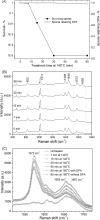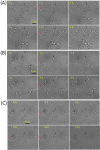Germination, Outgrowth, and Vegetative-Growth Kinetics of Dry-Heat-Treated Individual Spores of Bacillus Species
- PMID: 29330188
- PMCID: PMC5861817
- DOI: 10.1128/AEM.02618-17
Germination, Outgrowth, and Vegetative-Growth Kinetics of Dry-Heat-Treated Individual Spores of Bacillus Species
Abstract
DNA damage kills dry-heated spores of Bacillus subtilis, but dry-heat-treatment effects on spore germination and outgrowth have not been studied. This is important, since if dry-heat-killed spores germinate and undergo outgrowth, toxic proteins could be synthesized. Here, Raman spectroscopy and differential interference contrast microscopy were used to study germination and outgrowth of individual dry-heat-treated B. subtilis and Bacillus megaterium spores. The major findings in this work were as follows: (i) spores dry-heat-treated at 140°C for 20 min lost nearly all viability but retained their Ca2+-dipicolinic acid (CaDPA) depot; (ii) in most cases, dry-heat treatment increased the average times and variability of all major germination events in B. subtilis spore germination with nutrient germinants or CaDPA, and in one nutrient germination event with B. megaterium spores; (iii) B. subtilis spore germination with dodecylamine, which activates the spore CaDPA release channel, was unaffected by dry-heat treatment; (iv) these results indicate that dry-heat treatment likely damages spore proteins important in nutrient germinant recognition and cortex peptidoglycan hydrolysis, but not CaDPA release itself; and (v) analysis of single spores incubated on nutrient-rich agar showed that while dry-heat-treated spores that are dead can complete germination, they cannot proceed into outgrowth and thus not to vegetative growth. The results of this study provide new information on the effects of dry heat on bacterial spores and indicate that dry-heat sterilization regimens should produce spores that cannot outgrow and thus cannot synthesize potentially dangerous proteins.IMPORTANCE Much research has shown that high-temperature dry heat is a promising means for the inactivation of spores on medical devices and spacecraft decontamination. Dry heat is known to kill Bacillus subtilis spores by DNA damage. However, knowledge about the effects of dry-heat treatment on spore germination and outgrowth is limited, especially at the single spore level. In the current work, Raman spectroscopy and differential interference contrast microscopy were used to analyze CaDPA levels in and kinetics of nutrient- and non-nutrient germination of multiple individual dry-heat-treated B. subtilis and Bacillus megaterium spores that were largely dead. The outgrowth and subsequent cell division of these germinated but dead dry-heat-treated spores were also examined. The knowledge obtained in this study will help understand the effects of dry heat on spores both on Earth and in space, and indicates that dry heat can be safely used for sterilization purposes.
Keywords: Bacillus; dry-heat treatment; germination; outgrowth; spores; vegetative growth.
Copyright © 2018 American Society for Microbiology.
Figures







Similar articles
-
Kinetics of germination of wet-heat-treated individual spores of Bacillus species, monitored by Raman spectroscopy and differential interference contrast microscopy.Appl Environ Microbiol. 2011 May;77(10):3368-79. doi: 10.1128/AEM.00046-11. Epub 2011 Mar 25. Appl Environ Microbiol. 2011. PMID: 21441336 Free PMC article.
-
Use of Raman Spectroscopy and Phase-Contrast Microscopy To Characterize Cold Atmospheric Plasma Inactivation of Individual Bacterial Spores.Appl Environ Microbiol. 2016 Sep 16;82(19):5775-84. doi: 10.1128/AEM.01669-16. Print 2016 Oct 1. Appl Environ Microbiol. 2016. PMID: 27422840 Free PMC article.
-
Characterization of the Dynamic Germination of Individual Clostridium difficile Spores Using Raman Spectroscopy and Differential Interference Contrast Microscopy.J Bacteriol. 2015 Jul;197(14):2361-73. doi: 10.1128/JB.00200-15. Epub 2015 May 4. J Bacteriol. 2015. PMID: 25939833 Free PMC article.
-
Spores of Bacillus subtilis: their resistance to and killing by radiation, heat and chemicals.J Appl Microbiol. 2006 Sep;101(3):514-25. doi: 10.1111/j.1365-2672.2005.02736.x. J Appl Microbiol. 2006. PMID: 16907802 Review.
-
The role of peptidoglycan structure and structural dynamics during endospore dormancy and germination.Antonie Van Leeuwenhoek. 1999 May;75(4):299-307. doi: 10.1023/a:1001800507443. Antonie Van Leeuwenhoek. 1999. PMID: 10510717 Review.
Cited by
-
Targeting the Impossible: A Review of New Strategies against Endospores.Antibiotics (Basel). 2023 Jan 26;12(2):248. doi: 10.3390/antibiotics12020248. Antibiotics (Basel). 2023. PMID: 36830159 Free PMC article. Review.
-
Preventing the Transmission of Murine Norovirus to Mice (Mus musculus) by Using Dry-heat Sterilization.J Am Assoc Lab Anim Sci. 2022 Sep 1;61(5):419-423. doi: 10.30802/AALAS-JAALAS-21-000138. Epub 2022 Aug 30. J Am Assoc Lab Anim Sci. 2022. PMID: 36041827 Free PMC article.
-
Effects of Heavy Ion Particle Irradiation on Spore Germination of Bacillus spp. from Extremely Hot and Cold Environments.Life (Basel). 2020 Oct 30;10(11):264. doi: 10.3390/life10110264. Life (Basel). 2020. PMID: 33143156 Free PMC article.
-
What's new and notable in bacterial spore killing!World J Microbiol Biotechnol. 2021 Aug 5;37(8):144. doi: 10.1007/s11274-021-03108-0. World J Microbiol Biotechnol. 2021. PMID: 34351499 Free PMC article. Review.
-
Heat Activation and Inactivation of Bacterial Spores: Is There an Overlap?Appl Environ Microbiol. 2022 Mar 8;88(5):e0232421. doi: 10.1128/aem.02324-21. Epub 2022 Jan 12. Appl Environ Microbiol. 2022. PMID: 35020450 Free PMC article.
References
-
- Setlow P, Johnson EA. 2012. Spores and their significance, p 45–79. In Doyle MP, Buchanan R (ed), Food microbiology: fundamentals and frontiers, 4th ed ASM Press, Washington, DC.
-
- Gerhardt P, Marquis RE. 1989. Spore thermoresistance mechanisms, p 43–63. In Smith I, Slepecky RA, Setlow P (ed), Regulation of prokaryotic development. American Society for Microbiology, Washington, DC.
Publication types
MeSH terms
LinkOut - more resources
Full Text Sources
Other Literature Sources
Miscellaneous

